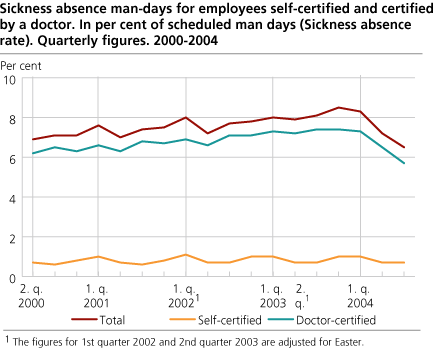Content
Published:
This is an archived release.
Marked fall in sickness absence
The total sickness absence fell from 8.1 to 6.5 per cent from the third quarter of 2003 to the third quarter of 2004. Absence certified by a doctor fell from 7.4 to 5.7 per cent, while self-certified absence remained flat at 0.7 per cent.
The sickness absence rate for men fell from 6.9 to 5.4 per cent, and the rate for women fell from 9.7 to 7.8 per cent. Compared with the third quarter of 2003, the sickness absence rate has fallen by 8.9 per cent..
Decrease in all industries
The strongest decrease in sickness absence was recorded in construction, manufacturing, health and social work, transport and communication.
Sectors
There was a reduction in sickness absence in all sectors, but the decrease was smallest in the central government sector. However, this sector has had the lowest absence rate of all sectors since the third quarter of 2003. The local government sector had the highest absence rate.
The following comments are based on figures for sickness absence certified by a doctor, which represent approximately 90 per cent of the total absence. The survey on self-certified absence only contains information on industry and gender.
Decrease in all age groups
The fall in sickness absence was evident among men and women in all age groups. Among men, the oldest age groups had the strongest fall in absence and among 60-64 year-olds the recorded fall in sickness absence was 2.1 percentage points. This pattern is also evident among women. In addition, the positive development from the second quarter continued for women aged 30-34, as a relatively strong decline was recorded in this group.
Decrease in all counties
Although the fall in doctor-certified sickness absence took place in all counties, it was strongest in Nord-Trøndelag, Nordland and Finnmark. Rogaland still has the lowest sickness absence rate, at 4.3 per cent. Finnmark continues to have the highest rate, at 6.9 per cent.
Tables:
- Table 1 Sickness absence man-days for employees self-certified and certified by a doctor. In per cent of scheduled man-days (sickness absence rate). Quarterly figures. 2000-2004
- Table 2 Sickness absence man-days for employees self-certified and certified by a doctor, by sex. In per cent of scheduled man-days (sickness absence rate). Quarterly figures. 2000-2004
- Table 3 Sickness absence man-days for employees self-certified and certified by a doctor, by industry and type of sickness absence. In per cent of scheduled man days (Sickness absence rate). Quarterly figures. 2000-2004
Contact
-
Arbeidsmarked og lønn
E-mail: arbeidsmarked@ssb.no
-
Unn H. Høydahl
E-mail: unnh.hoydahl@ssb.no
tel.: (+47) 40 90 23 77

